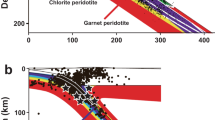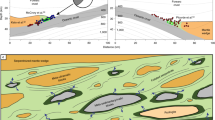Abstract
SERPENTINITE bodies characteristically occur in regions that have undergone an orogenesis of alpine type1. The more recent recognition that significant quantities of serpentinites are associated with the oceanic crust, oceanic trenches and mid-oceanic ridges2 extends the possible role of serpentinites in tectonic processes which involve the crust and upper mantle. Thus the experimental deformation of serpentinite at high pressures and temperatures3 has important implications for theories of the tectonic emplacement of serpentinites and principal tectonic processes such as mountain building. Raleigh and Paterson3 have found that at low temperatures and high pressures serpentine has strength comparable with granite. With an increase in temperature sealed specimens showed marked weakening accompanied by the development of brittleness.
This is a preview of subscription content, access via your institution
Access options
Subscribe to this journal
Receive 51 print issues and online access
$199.00 per year
only $3.90 per issue
Buy this article
- Purchase on Springer Link
- Instant access to full article PDF
Prices may be subject to local taxes which are calculated during checkout
Similar content being viewed by others
References
Turner, F. J., and Verhoogen, J., Igneous and Metamorphic Petrology, second ed. (McGraw-Hill, New York, 1960).
Burk, C. A., A Study of Serpentinite, 175 (Nat. Acad. Sci—Nat. Res. Council Publ. 1188, 1964).
Raleigh, C. B., and Paterson, M. S., J. Geophys. Res., 70, 3965 (1965).
Bowen, N. L., and Tuttle, O. F., Bull. Geol. Soc. Amer., 60, 439 (1949).
Pistorius, C. W. F. T., Neues Jahrb. Mineral., 11, 283 (1963).
Kitahara, S., Takenouchi, S., and Kennedy, G. C., Amer. J. Sci., 264, 223 (1966).
Yoder, jun., H. S., Ann. Rep. Director Geophys. Lab. Carnegie Institution, Washington, DC, 65, 279 (1967).
Roy, D. M., and Roy, R., Amer. J. Sci., 255, 573 (1957).
Greenwood, H. J., J. Petrol., 4, 317 (1963).
Scarfe, C. M., and Wyllie, P. J., Trans. Amer. Geophys. Union, 48, 225 (1967).
King, E. G., Barany, R., Weller, W. W., and Pankratz, L. B., Thermodynamic Properties of Forsterite and Serpentine (US Dept. Interior, Bureau of Mines R. I. 6962, 1967).
Hostetler, P. B., Coleman, R. G., Mumpton, F. A., and Evans, B. W., Amer. Min., 51, 75 (1966).
Author information
Authors and Affiliations
Rights and permissions
About this article
Cite this article
SCARFE, C., WYLLIE, P. Serpentine Dehydration Curves and their Bearing on Serpentinite Deformation in Orogenesis. Nature 215, 945–946 (1967). https://doi.org/10.1038/215945a0
Received:
Issue Date:
DOI: https://doi.org/10.1038/215945a0
This article is cited by
-
Dehydration reactions and micro/nanostructures in experimentally-deformed serpentinites
Contributions to Mineralogy and Petrology (2009)
-
Dehydration temperature of serpentine at elevated temperatures and pressures by electrical conductivity method and its implications
Chinese Journal of Geochemistry (1996)
-
Der Stubachtal-Ultramafitit-Komplex (Salzburg, �sterreich)
TMPM Tschermaks Mineralogische und Petrographische Mitteilungen (1978)
-
Reaction rims between olivine and plagioclase in metaperidotites, �tztal Alps, Austria
Contributions to Mineralogy and Petrology (1974)
-
Stability relations of K2Mg5Si12O30, and end member of the merrihueite-roedderite group of meteoritic minerals
Contributions to Mineralogy and Petrology (1969)
Comments
By submitting a comment you agree to abide by our Terms and Community Guidelines. If you find something abusive or that does not comply with our terms or guidelines please flag it as inappropriate.



